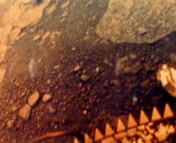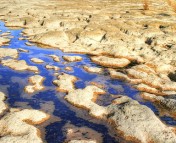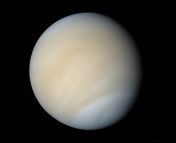Title: Dry late accretion inferred from Venus’s coupled atmosphere and internal evolution (Nature Geoscience, April 2020)
Authors: Gillman, G. J. Golabek, S. N. Raymond, M. Schönbächler, P. J. Tackley, V. Dehant and V. Debaille
First author affiliation: Laboratoire G-Time, Université Libre de Bruxelles, Brussels, Belgium
Are rocky planets born habitable, or do they have habitability thrust upon them? Despite being similar in size, and mostly forming from roughly the same rocky material available in the early Solar System, the Earth boasts vast oceans, abundant forests, and capybaras, whereas Venus has little more to show for its evolution than a bone-dry, punishingly thick CO2 atmosphere. However, a growing group of planetary scientists is interested in the idea of an “early habitable Venus,” suggesting that Venus once looked much more like Earth, and potentially even had an ocean. The first obvious question is, well, where is all of Venus’ water now? And was there ever enough of it to form lakes or oceans on Venus’ surface?
Growing pains…
Planets start their life as rubble piles racing around the Sun, first gathering dust and rocks, and later other protoplanets until they reach most of their final size. Initially, planets are a largely uniform mixture of minerals and metals. However, over time, the heat from impacts and radioactive decay melts and separates the mixture out into a dense metal core surrounded by a less-dense rocky outer layer. This outer part is initially a bubbling soup of molten rock, or “magma ocean”, which not only releases gasses into the atmosphere as it cools and solidifies, but also reacts with atmospheric water vapor and oxygen, trapping them in minerals.
Planets rebuild their atmospheres through volcanic eruptions, and can receive more water and gas (“volatiles”) from space. The rocks in the top few 100 km of the Earth are rich in elements that should have hitched a ride with iron down to the Earth’s core, which supports the idea of a late growth spurt (“late accretion”) during which comets and meteorites added the last 0.5-2% of Earth’s mass. A big challenge in planetary science is figuring out when this took place, and what kind of material it brought to Earth – was it mostly dry rock, or did comets and meteorites from the outer Solar System also bring water? Today’s paper combines mathematical models of atmospheric evolution of planets with their present day oxygen concentration to try and answer the same question for Venus!
You look parched!
The paper assumes Venus’ early atmosphere was dry and oxygen-free before late accretion started. The reason for this assumption is that the magma ocean stage in a planet’s life is thought to be very effective at removing water and oxygen from planetary atmospheres through chemical reactions. They used mathematical models to simulate the effects of a fixed mass of meteorites impacting Venus. Variables they manipulate are the timing of impacts, and the number of different types of meteorites (i.e. dry vs. water rich) to see how much water is added to the atmosphere by different scenarios.
Water in Venus’ atmosphere doesn’t just get to hang around, though! UV radiation from the Sun splits water vapor into hydrogen and oxygen. Even with a less active Sun, particle collisions in
the upper atmosphere and the effects of solar wind can still remove gas from planetary atmospheres. These processes are much more efficient at booting hydrogen, because of its low mass, into space, leaving the oxygen left over from dissociated water behind in the atmosphere. However, there’s only a tiny amount of oxygen left in Venus’ atmosphere today. The paper predicts how much oxygen Venus could have lost over the past 4.5 billion years, taking into account the changing radiation from the Sun (which drives splitting of water and loss of gasses to space), and the changing atmospheric pressure as volcanoes add carbon dioxide and nitrogen to Venus’ atmosphere. Simply, the more oxygen Venus was able to lose, the more water it could have received from meteorites!
Habitable or hopeless?
Figure 1. How much water could Venus have had added to its atmosphere during its lifetime? The black curve shows the maximum amount of water that can be accounted for by loss of oxygen to space. The blue and purple curves show what happens to the water and oxygen left in Venus’ atmosphere after being hit by meteorites carrying different amounts of water. The jagged red curve shows what happens when only dry meteorites hit Venus. Adapted from Gillman et al. 2020 Figure 3.
The results of this paper show Venus is surprisingly bad at losing oxygen to space! As a result, the meteorites that reached Venus during late accretion were either 97.5% dry, or all of the meteorites had to arrive within the first 2% of Venus’ lifetime to have enough time to get rid of all the oxygen (Figure 1). According to the models in this paper, the absolute maximum amount of water lost from Venus is less than 1/10th of all the water on Earth’s surface today (Figure 1), which could mean that Venus has always been too dry to have Earth-like conditions, and potentially too dry to be habitable at all.
But all is perhaps not lost for the early habitable Venus hypothesis! Work using detailed mathematical models of Venus’ early climate suggest that habitable conditions might still be attainable even with only small amounts of water available at the surface. There are other ways in which oxygen can be scrubbed from a planet’s atmosphere to match the present day oxygen observations, including rusting the iron in volcanic rocks. Venus is absolutely covered in iron-rich lava flows, which can react with oxygen, trapping it permanently in minerals, and making room for more water in Venus’ early atmosphere!
Astrobite edited by Suchitra (Suchi) Narayanan
Featured image credit: NASA Venus through Time




